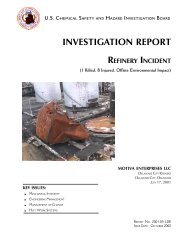CTA Report, Draft 1, ISP Review - US Chemical Safety and Hazard ...
CTA Report, Draft 1, ISP Review - US Chemical Safety and Hazard ...
CTA Report, Draft 1, ISP Review - US Chemical Safety and Hazard ...
You also want an ePaper? Increase the reach of your titles
YUMPU automatically turns print PDFs into web optimized ePapers that Google loves.
Table 2<br />
Dust Properties for Determining Fire <strong>and</strong> Explosion <strong>Hazard</strong>s (a)<br />
Elements Properties Significance<br />
Fuel<br />
Explosion<br />
Severity (Kst)<br />
value<br />
Maximum rate of pressure rise normalized to a 1.0-m 3<br />
volume, which is a relative measurement of energy of the<br />
dust explosion. The greater the Kst value, the more<br />
energetic the explosion.<br />
Moisture content Affects ease of ignition <strong>and</strong> ability to sustain an explosion.<br />
Increasing moisture content increases ignition energy (for<br />
some dusts, the increase may be exponential) <strong>and</strong> reduces<br />
explosion severity (i.e., water vapor acts as inert heat sink).<br />
Ignition Minimum ignition<br />
energy (MIE)<br />
Provides information on the lowest energy required to ignite<br />
the most readily ignitable dust/air mixture at atmospheric<br />
pressure <strong>and</strong> room temperature; a combustible dust with a<br />
low MIE is easily ignited. Ignition energies for dust clouds<br />
are usually higher than for gases or vapors—typically a<br />
fraction of a millijoule for gases <strong>and</strong> 1–10 millijoules for<br />
dust.<br />
Oxygen Oxygen content Less oxygen in the air reduces explosion severity by<br />
limiting rate of combustion <strong>and</strong> increases ignition energy.<br />
Suspension/<br />
confinement<br />
Degree of<br />
dispersion<br />
Particle<br />
size/shape<br />
Minimum<br />
explosive<br />
concentration<br />
(MEC)<br />
Usually dependent on the way dust is dispersed <strong>and</strong> level<br />
of turbulence. An evenly suspended <strong>and</strong> less turbulent<br />
dust cloud is more easily ignited <strong>and</strong> burns more easily.<br />
Reduction in particle size increases surface area <strong>and</strong><br />
decreases MIE; the smaller the dust particle, the more<br />
easily it is suspended. Particles with high surface area per<br />
unit volume exhibit low MIE, low MEC, <strong>and</strong> high Kst.<br />
(a) This table highlights the main characteristics of combustible dusts.<br />
Dusts, like gases <strong>and</strong> vapors, form explosive clouds only if<br />
dust concentration lies between certain limits, known as the<br />
lower (LEL) <strong>and</strong> upper explosive limit. For dusts, LEL is<br />
also commonly referred to as MEC.<br />
50









